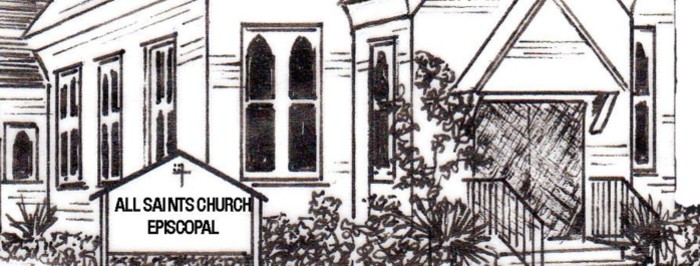Over 150 years ago, in the 1860s, people in and around Ponchatoula, sought to learn about and understand God in their lives. To meet this desire, a businessman-farmer who had migrated from Philadelphia, PA, Samuel Wiggins, started a Christian Sunday School. Those interested began to meet in a local schoolhouse, then in private homes, and other buildings. They grew in the love of God.

These were turbulent years in Louisiana and in the United States. Even the little town of Ponchatoula, with a population around 320, was affected by the Civil War. The Episcopal Diocese of Louisiana, established in 1841, was still young and focused primarily on internal growth and missionary outreach.
By 1869, war-time strife had subsided, and the town began to grow a little through its location along the railroad. The little Sunday School had acquired a name, the Church of the Annunciation, although it had no church building and no affiliation with a specific Christian denomination.
Possibly due to the missionary outreach of the young diocese, the first Episcopal service was conducted at the Sunday School by the Reverend Charles Hilton in town in February of 1871. On the business end, 45 members of the Sunday School incorporated as a church in 1871 under the leadership of Sr. Warden Samuel Wiggins, Jr. Warden Theodore Emile Olsen, Treasurer Thomas M. Akers, Secretary Festus Mix and vestrymen Eugene N. Vinyard, Robert Duncan, and Judge Calvin Iverson Bradley. On the spiritual end, the Church of the Annunciation was admitted into the Episcopal Diocese of Louisiana in April 1871. A year later (May 1872), Judge Bradley donated two adjacent lots (5 & 12, square 34) on North Fifth St. and North Fourth St. close to east Pine St. for the erection and completion of a house of divine worship. Mr. Wiggins was licensed by the diocese as a lay reader in 1872, and records show that he conducted worship services with some regularity. Old records list the names of several different priests who came at various times for baptism, confirmation, marriages, and burials.
Samuel Wiggins and the little congregation began to raise funds for a church building, selling eggs, butter and other produce in New Orleans at every opportunity. A deacon and Episcopal missionary in the St. Tammany and Tangipahoa parishes area, Herman Cape Duncan, gave Wiggins a bag of cotton seed, which he distributed it to his little flock, instructing them to plant the seed, tend their crop, and bring the harvest to Sunday School. Although statewide, the cotton crop in 1870 was destroyed by the “cotton worm” (boll weevil), the crop planted with Duncan’s seed yielded a half a bale of cotton, sold in 1872. Many volunteered labor and materials for construction of that first church building as well. At the dedication in 1873, the name was changed to All Saints Episcopal Church. It served a growing community until 1909 when the structure was among many severely damaged or destroyed by a tornado.
From 1909 to 1924, the All Saints congregation in Ponchatoula worshipped without a church building, but by 1919, the members were actively raising funds and planning for a new one. They held suppers and rummage sales as well as creative town-wide events like special movies at the Ideal Theater and a town-wide lawn party with games, dancing, and refreshments. Donations were welcomed. Eventually accumulating enough money to start construction, they bought a lot in 1922 west of the railroad tracks at the corner of West Hickory and North Seventh streets for $500. And in 1924, the present sanctuary building was completed. Rev. Edward L. McGrady officiated at the dedication in December of that year. Final payment on the mortgage was made in 1929, but church records show that the task was not easy. There are many letters on file of correspondence between the men of the church and the bank, begging the bank for just a “little more time” to pay off the mortgage.
The congregation continued to grow, leading the ladies of All Saints to raise funds in the 1950s to construct a parish hall. With the addition of a loan from the Episcopal Diocese of Louisiana, it was built in a couple of years and dedicated in September 1955. Air conditioning was added in the early 1960s. The sanctuary was completely renovated in 1990 to include the narthex and main entrance with its red doors. The membership had grown by then to 121. In September 2001, the church spontaneously conducted a prayer vigil for the entire community reacting to the 9/11 attack on the United States. In 2017, a memorial garden linking the two buildings was constructed.
Sources:
Carter, W. Hodding, and Betty Werlien Carter. So Great a House: a History of the Episcopal Church in Louisiana and of Christ Church Cathedral 1805-1955. University Press. Sewanee, TN. 1955.
Davis, Perry L., A Study of the Need of a Community School in Ponchatoula, LA. M.A. Thesis, Mississippi Southern College, 1949
Perrin, James M. Hometown Ponchatoula: a Community History of Ponchatoula, Louisiana. 2000. p.142
Perrin, James M. Hometown Ponchatoula Revisited. 2018
Church Records of All Saints Episcopal Church and Archives of the Episcopal Diocese of Louisiana, Christ Church Cathedral, New Orleans, LA.
Newspaper articles on rebuilding and fundraising after first building was destroyed:
Times Picayune, New Orleans, LA Nov 17, 1919
State Times Advocate, Baton Rouge, LA., Dec. 30, 1924
Times Picayune, New Orleans, LA. Dec. 20, 1919
The Enterprise, Jan. 11 & 12, 1924/ Jan 27, 1933.
